wrought iron vs iron
Wrought Iron vs. Cast Iron Understanding the Differences
When it comes to metalworking and construction, two terms that often come up are wrought iron and cast iron. Both have unique properties and uses, but they are fundamentally different in terms of their composition, production methods, and applications. Understanding these differences is essential for anyone working in architecture, sculpture, or even basic home improvement projects.
Production Methods
The primary difference between wrought iron and cast iron lies in their production methods. Wrought iron is produced by repeatedly hammering or rolling iron, which refines the metal and removes impurities. This process imparts a fibrous structure to the material, making it more ductile and malleable. Wrought iron typically contains a very low carbon content, usually less than 0.08%, which contributes to its strength and ability to be shaped without breaking.
In contrast, cast iron is produced by melting iron and pouring it into molds where it solidifies. This process allows for more complex and intricate shapes but results in a material that is much more brittle. Cast iron has a higher carbon content, generally between 2% to 4%, which enhances its ability to withstand compression but also contributes to its susceptibility to cracking under tensile stress.
Properties
The properties of wrought and cast iron further distinguish them. Wrought iron is known for its toughness, resilience, and malleability. It can be easily forged and welded, making it suitable for applications requiring bending and deformation. Wrought iron also has a beautiful appearance due to its fibrous texture, often used in decorative elements such as gates, railings, and furniture.
On the other hand, cast iron has excellent wear resistance and can bear heavy loads, making it suitable for construction and machine parts. However, its brittleness limits its use in applications where flexibility is required. Cast iron can be found in items like pipes, cookware, and engine blocks. The distinctive sound it makes when struck—a ringing tone—also characterizes it.
wrought iron vs iron

Applications
The applications of wrought iron and cast iron reflect their respective properties. Wrought iron's malleability and superior tensile strength make it ideal for ornamental work and structural elements where weight and aesthetics are priorities. Historical architecture often features wrought iron in the form of intricate fencing and decorative grillwork.
Cast iron, with its superior compressive strength, is often used in heavy-duty applications. Its ability to retain heat makes it popular for cookware, such as Dutch ovens and skillets. Additionally, its use in construction can be seen in foundations and building facades, especially in historical buildings where the material contributes to both structural integrity and aesthetic appeal.
Maintenance and Durability
When it comes to maintenance, wrought iron requires a bit more care due to its susceptibility to rust when exposed to moisture. Regular painting and sealing can help protect it from the elements, ensuring its longevity. On the other hand, cast iron is generally more resistant to rust, especially if it has a protective enamel coating. However, it can chip and crack if mishandled, so care must be taken with cast iron cookware and fixtures.
Conclusion
In conclusion, wrought iron and cast iron serve different purposes and come with distinct advantages and disadvantages. Wrought iron is favored for its beauty and flexibility, making it an excellent choice for decorative applications. Conversely, cast iron shines in applications requiring strength and resistance to wear, though it sacrifices some of the beauty that wrought iron offers.
For builders, designers, and artisans, understanding these differences is crucial. Choosing the right material for the task at hand can significantly impact the functionality, aesthetics, and longevity of the final product. Whether you are restoring a historical piece of architecture or choosing cookware for your kitchen, knowing when to utilize wrought iron or cast iron can make all the difference in achieving your desired results.
-
Wrought Iron Components: Timeless Elegance and Structural StrengthNewsJul.28,2025
-
Window Hardware Essentials: Rollers, Handles, and Locking SolutionsNewsJul.28,2025
-
Small Agricultural Processing Machines: Corn Threshers, Cassava Chippers, Grain Peelers & Chaff CuttersNewsJul.28,2025
-
Sliding Rollers: Smooth, Silent, and Built to LastNewsJul.28,2025
-
Cast Iron Stoves: Timeless Heating with Modern EfficiencyNewsJul.28,2025
-
Cast Iron Pipe and Fitting: Durable, Fire-Resistant Solutions for Plumbing and DrainageNewsJul.28,2025
-
 Wrought Iron Components: Timeless Elegance and Structural StrengthJul-28-2025Wrought Iron Components: Timeless Elegance and Structural Strength
Wrought Iron Components: Timeless Elegance and Structural StrengthJul-28-2025Wrought Iron Components: Timeless Elegance and Structural Strength -
 Window Hardware Essentials: Rollers, Handles, and Locking SolutionsJul-28-2025Window Hardware Essentials: Rollers, Handles, and Locking Solutions
Window Hardware Essentials: Rollers, Handles, and Locking SolutionsJul-28-2025Window Hardware Essentials: Rollers, Handles, and Locking Solutions -
 Small Agricultural Processing Machines: Corn Threshers, Cassava Chippers, Grain Peelers & Chaff CuttersJul-28-2025Small Agricultural Processing Machines: Corn Threshers, Cassava Chippers, Grain Peelers & Chaff Cutters
Small Agricultural Processing Machines: Corn Threshers, Cassava Chippers, Grain Peelers & Chaff CuttersJul-28-2025Small Agricultural Processing Machines: Corn Threshers, Cassava Chippers, Grain Peelers & Chaff Cutters












